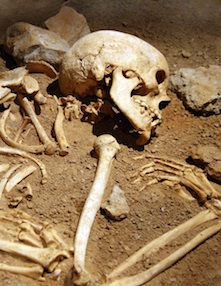By Rebecca McCarron
As college students across the United States begin new semesters, it will come as no surprise that students at liberal arts institutions will be heading back to courses like English, philosophy, and history. What many may find interesting is the new natural science class some students have begun to incorporate in their schedules, forensic anthropology. At first glance, the name of this class may give some pause, what exactly is forensic anthropology?
As the anthropologists for the Smithsonian’s National Museum of Natural History’s online exhibit Written in Bone explain, the subject has been a part of human history for quite some time. The tradition became distinct beginning in 1903, when Ales Hrdlicka, came to work as the Smithsonian’s first physical anthropologist. In the little over a century since then, forensic anthropologists at the Smithsonian have continued working with various agencies, like the FBI and law enforcement officials, in order to solve both individual criminal cases and to aid in identifying and recovering the remains of victims of mass disasters and war crimes.
The Smithsonian’s work also aims to train the next generation of forensic anthropologists. One of the best ways to accomplish this is through their human comparative skeletal collections. These collections represent over thirty thousand sets of catalogued human remains form various populations worldwide. The museum’s physical anthropology department also houses the anatomical collection amassed by Robert J. Terry between 1921 and 1946, which consists of nearly one thousand seven hundred complete skeletons. These collections make the Smithsonian a major resource for research on bone pathology, skeletal biology, and forensic anthropology. However this practice has spread, as individual colleges and universities have also begun to build collections and invest time and resources in training students to become a part of this expanding field.
As Elissa Nadworny, an NPR digital correspondent, explains in her article “If These Bones Could Talk: The Stories Human Skeletons Can Tell,” the University of Tennessee Knoxville houses an extensive collection of bones formally called the Bass Donated Skeletal Collection, named for orensic anthropologist Bill Bass who began the facility in 1981. The program is, as the title suggests, based on donations.
While still alive, people sign up to donate their bodies to the Bass Collection. Remains are first studied as they decompose in a field owned by the university and are later brought to the lab. Once in the lab, the bones are cleaned and examined as teaching tools. Anthropologists, detectives, and students come to the lab to hone their skills and learn how to identify gender, age, ancestry, and medical history of a specific individual from skeletal remains. Working with whole skeletons helps researchers learn more, so that in real life cases when investigative teams must work with less (maybe just a few bones) they can glean as much information as possible from limited evidence.
According to Kristina Killgrove, a writer for Forbes, after about twenty-five years of being the only facility of its kind in the country, the Bass Collection is now complemented by the similar labs built at various universities including Western Carolina University, Texas State University, and Colorado Mesa University. As of now there are only six of these facilities, or “body farms,” in the country, though plans exist to establish others in Florida, Wisconsin, and Pennsylvania. This field is clearly growing and though its purposes are grisly to say the least the purposes are a sad necessity.
Despite all of this information, there is still the lingering question of just how the field relates to a liberal arts education? As Smithsonian museum specialist and forensic anthropologist Kari Bruwelheide explains: “We treat all remains coming into the lab as individuals, each with a unique life story reflected in his or her skeleton. The desire to learn more about the person encourages us to try new technologies and methods of obtaining even greater amounts of information. It is detective work of the most satisfying kind because it tells us just a little bit more of the human story.
It seems many forensic anthropologists see themselves as researchers whose work provides a voice for the voiceless victims of various tragedies. Might this kind of work, which expands our understanding of one another and contributes to our evolving human story, come to have a permanent place in the liberal arts education?
Rebecca McCarron is a junior at The Catholic University of America majoring in history and minoring in Spanish. The Catholic University of America is home to the Beta of D.C. Chapter of Phi Beta Kappa.




